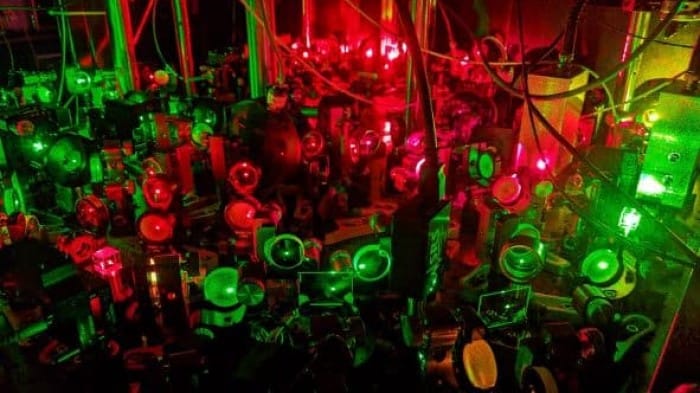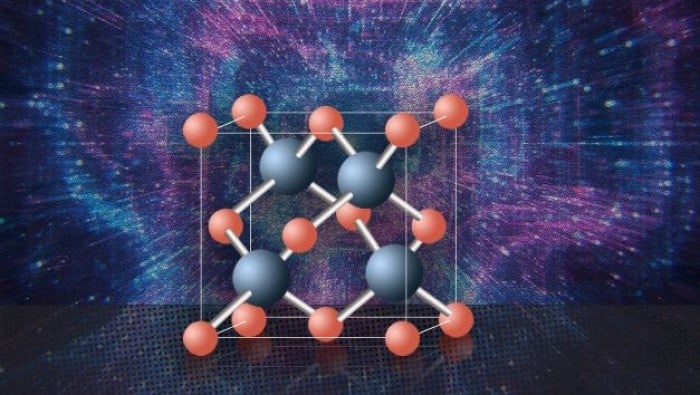
Physics World is delighted to announce its top 10 Breakthroughs of the Year for 2022, which span everything from quantum and medical physics to astronomy and condensed matter. The overall Physics World Breakthrough of the Year will be revealed on Wednesday 14 December.
The 10 Breakthroughs were selected by a panel of Physics World editors, who sifted through hundreds of research updates published on the website this year across all fields of physics. In addition to having been reported in Physics World in 2022, selections must meet the following criteria:
- Significant advance in knowledge or understanding
- Importance of work for scientific progress and/or development of real-world applications
- Of general interest to Physics World readers
The Top 10 Breakthroughs for 2022 are listed below in no particular order. Come back next week to find out which one has bagged the overall Physics World Breakthrough of the Year award.
Ushering in a new era for ultracold chemistry

To Bo Zhao, Jian-Wei Pan and colleagues at the University of Science and Technology of China (USTC) and the Chinese Academy of Sciences in Beijing; and independently to John Doyle and colleagues at Harvard University in the US, for creating the first ultracold polyatomic molecules.
Although physicists have been cooling atoms to a fraction above absolute zero for more than 30 years, and the first ultracold diatomic molecules appeared in the mid-2000s, the goal of making ultracold molecules containing three or more atoms had proved elusive.
Using different and complementary techniques, the USTC and Harvard teams produced samples of triatomic sodium-potassium molecules at 220 nK and sodium hydroxide at 110 µK, respectively. Their achievement paves the way for new research in both physics and chemistry, with studies of ultracold chemical reactions, novel forms of quantum simulation, and tests of fundamental science all closer to being realized thanks to these multi-atom molecular platforms.
Observing the tetraneutron
To Meytal Duer at the Institute for Nuclear Physics at Germany’s Technical University of Darmstadt and the rest of the SAMURAI Collaboration for observing the tetraneutron and showing that uncharged nuclear matter exists, if only for a very short time.
Comprising four neutrons, the tetraneutron was spotted at the RIKEN Nishina Centre’s Radioactive Ion Beam Factory in Japan. The tetraneutrons were created by firing helium-8 nuclei at a target of liquid hydrogen. The collisions can split a helium-8 nucleus into an alpha particle (two protons and two neutrons) and a tetraneutron.
By detecting the recoiling alpha particles and hydrogen nuclei, the team worked out that the four neutrons existed in an unbound tetraneutron state for just 10−22 s. The statistical significance of the observation is greater than 5σ, putting it over the threshold for a discovery in particle physics. The team now plans to study the individual neutrons within tetraneutrons and look for new particles containing six and eight neutrons.
Super-efficient electricity generation
To Alina LaPotin, Asegun Henry and colleagues at the Massachusetts Institute of Technology and the National Renewable Energy Laboratory, US, for constructing a thermophotovoltaic (TPV) cell with an efficiency of more than 40%.
The new TPV cell is the first solid-state heat engine of any kind to convert infrared light into electrical energy more efficiently than a turbine-based generator, and it can operate with a broad range of possible heat sources. These include thermal energy storage systems, solar radiation (via an intermediate radiation absorber) and waste heat as well as nuclear reactions or combustion. The device could therefore become an important component of a cleaner, greener electricity grid, and a complement to visible-light solar photovoltaic cells.
The fastest possible optoelectronic switch
To Marcus Ossiander, Martin Schultze and colleagues at the Max Planck Institute for Quantum Optics and LMU Munich in Germany; the Vienna University of Technology and the Graz University of Technology in Austria; and the CNR NANOTEC Institute of Nanotechnology in Italy, for defining and exploring the “speed limits” of optoelectronic switching in a physical device.
The team used laser pulses lasting just one femtosecond (10−15 s) to switch a sample of a dielectric material from an insulating to a conducting state at the speed needed to realize a switch that operates 1000 trillion times a second (one petahertz). Although the apartment-sized apparatus required to drive this super-fast switch means it will not appear in practical devices any time soon, the results imply a fundamental limit for classical signal processing and suggest that petahertz solid-state optoelectronics is, in principle, feasible.
Opening a new window on the universe

To NASA, the Canadian Space Agency and the European Space Agency for the deployment and first images from the James Webb Space Telescope (JWST).
Following years of delays and cost hikes, the $10bn JWST finally launched on 25 December 2021. For many space probes, launch is the most dangerous part of the mission, but the JWST also had to survive a series of hazardous deep-space unpacking manoeuvres, which involved unfolding its 6.5 m primary mirror as well as unfurling its tennis-court-sized sunshield.
Prior to launch, engineers identified 344 “single-point” failures that could have hampered the observatory’s mission, or worse, make it unusable. Remarkably, no issues were encountered and following the commissioning of the JWST’s science instruments, the observatory soon began taking data and capturing spectacular images of the cosmos.
The first JWST picture was announced by US president Joe Biden at a special event at the White House and many dazzling images have since been released. The observatory is expected to operate well into the 2030s and is already on course to revolutionize astronomy.
First-in-human FLASH proton therapy
To Emily Daugherty from the University of Cincinnati in the US and collaborators working on the FAST-01 trial for performing the first clinical trial of FLASH radiotherapy and the first-in-human use of FLASH proton therapy.
FLASH radiotherapy is an emerging treatment technique in which radiation is delivered at ultrahigh dose rates, an approach that is thought to spare healthy tissue while still effectively killing cancer cells. Using protons to deliver the ultrahigh-dose-rate radiation will allow treatment of tumours located deep inside the body.
The trial included 10 patients with painful bone metastases in their arms and legs, who received a single proton treatment delivered at 40 Gy/s or greater – some 1000 times the dose rate of conventional photon radiotherapy. The team demonstrated the feasibility of the clinical workflow and showed that FLASH proton therapy was as effective as conventional radiotherapy for pain relief, without causing unexpected side effects.
Perfecting light transmission and absorption
To a team led by Stefan Rotter of Austria’s Technical University of Vienna and Matthieu Davy of the University of Rennes in France for creating an anti-reflection structure that enables perfect transmission through complex media; along with a collaboration headed up by Rotter and Ori Katz from the Hebrew University of Jerusalem in Israel, for developing an “anti-laser” that enables any material to absorb all light from a wide range of angles.
In the first investigation, the researchers designed an anti-reflection layer that’s mathematically optimized to match the way waves would reflect from the front surface of an object. Placing this structure in front of a randomly disordered medium completely eliminates reflections and makes the object translucent to all incoming light waves.
In the second study, the team developed a coherent perfect absorber, based around a set of mirrors and lenses, that traps incoming light inside a cavity. Due to precisely calculated interference effects, the incident beam interferes with the beam reflected back between the mirrors, so that the reflected beam is almost completely extinguished.
Cubic boron arsenide is a champion semiconductor

To independent teams led by Gang Chen at the Massachusetts Institute of Technology in the US and Xinfeng Liu of the National Center for Nanoscience and Technology in Beijing, China for showing that cubic boron arsenide is one of the best semiconductors known to science.
The two groups did experiments that revealed that small, pure regions of the material have a much higher thermal conductivity and hole mobility than semiconductors such as silicon, which forms the basis of modern electronics. Silicon’s low hole mobility limits the speed at which silicon devices operate, while its low thermal conductivity causes electronic devices to overheat.
Cubic boron arsenide, in contrast, had long been predicted to outperform silicon on these measures, but researchers had struggled to create large enough single-crystal samples of the material to measure its properties. Now, however, both teams have now overcome this challenge, bringing the practical use of cubic boron arsenide one step closer.
Changing an asteroid’s orbit
To NASA and the Johns Hopkins Applied Physics Laboratory in the US for the first demonstration of “kinetic impact” by successfully changing the orbit of an asteroid.
Launched in November 2021, the Double Asteroid Redirection Test (DART) craft was the first-ever mission to investigate kinetic impact of an asteroid. Its target was a binary near-Earth asteroid system consisting of a 160-metre-diameter body called Dimorphos that orbits a larger 780-metre-diameter asteroid called Didymos.
Following an 11-million-kilometre journey to the asteroid system, in October DART successfully impacted Dimorphos while travelling at about 6 km/s. Days later, NASA confirmed that DART had successfully altered the Dimorphos’ orbit by 32 minutes – shortening the orbit from 11 hours and 55 minutes orbit to 11 hours and 23 minutes.
This change was some 25 times greater than the 73 seconds that NASA had defined as a minimum successful orbit period change. The results will also be used to assess how best to apply the kinetic impact technique for defending our planet.
Detecting an Aharonov–Bohm effect for gravity
To Chris Overstreet, Peter Asenbaum, Mark Kasevich and colleagues at Stanford University in the US for detecting an Aharonov–Bohm effect for gravity.
First predicted in 1949, the original Aharonov–Bohm effect is a quantum phenomenon whereby the wave function of a charged particle is affected by an electric or magnetic potential even when the particle is in a region of zero electric and magnetic fields. Since the 1960s, the effect has been observed by splitting a beam of electrons and sending the two beams on either side of a region containing a completely shielded magnetic field. When the beams are recombined at a detector, the Aharonov–Bohm effect is revealed as an interference between the beams.
Now, the Stanford physicists have observed a gravitational version of the effect using ultracold atoms. The team split the atoms into two groups that were separated by about 25 cm, with one group interacting gravitationally with a large mass. When recombined, the atoms displayed an interference that is consistent with an Aharonov–Bohm effect for gravity. The effect could be used to determine Newton’s gravitational constant to very high precision.
- Congratulations to all the teams who have been honoured – and stay tuned for the overall winner, which will be announced on Wednesday 14 December 2022.
